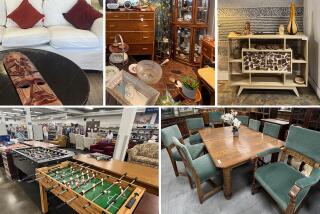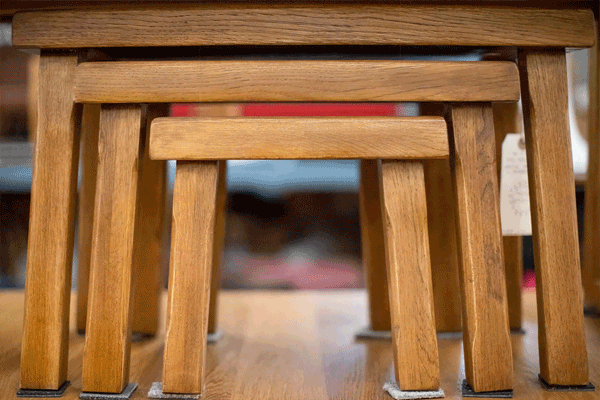Shop Owners Are Pioneers in Reviving Old West Style : Monterey Furniture Rides Back Out of Sunset
That low-slung, wooden couch with cushions covered in Mexican serapes is not cheesy: It’s Monterey, Jack.
What? You don’t remember the style of furniture that filled working-class Los Angeles ranch houses in the 1930s and ‘40s, spread East with the lore of Westerns, then met an inglorious end in the rumpus room?
Don’t blame Don Shorts and Dolores Fisher. The proprietors of a Ventura antiques shop, they take credit for rekindling interest in Monterey furniture, which is decorated with wrought-iron hinges, hand-painted donkeys, flowers and sombrero-bedecked figures.
“We like to be considered the pioneers in bringing this thing back to light,” explained Shorts, 54, who co-owns the Old California Store on East Thompson Boulevard with Fisher, 55.
Cowboy Style
Others may have received more publicity for selling the factory-made furniture that Ojai collector Bob Smith describes as “a motion-picture version of what cowboys might have had in the way of furniture--if they had furniture.”
But none of the handful of Monterey dealers has done more to research and promote a style whose history was little known 6 months ago, the couple’s colleagues agree.
“I would certainly give the most credit for the resurrection to Don and Dee,” said Jack Moore, a Pasadena antiques dealer who for 7 years has traded in the furniture that combines early California, Mexican and Western influences.
Shorts and Fisher have turned their 1926 home, which doubles as living quarters and a showroom, into a Monterey monument, with a rotating selection of dining room sets, bedroom sets, living room groupings, Mexican kitsch and at least three photographs of Will Rogers.
They also publish a newsletter on the furniture, serve as hosts at “openings” in the homes of clients, and organize outings to such shrines of Monterey furniture as Rogers’ 1921 ranch house in Pacific Palisades.
The couple even organized a museum exhibition last summer of the ersatz cowboy furniture. “Monterey: An Exhibition of California Rancho Furniture, Pottery and Art” filled one story and part of a second at the Santa Monica Heritage Museum.
An Introduction
The exhibition enhanced the furniture’s status as a collectible by popularizing it, antiques dealers say. It also introduced the style to Kenneth Trapp, a curator of decorative arts at the Oakland Museum. Now he plans to include it in an upcoming exhibition of California Craftsman furniture.
“It struck me as wonderfully ludicrous,” Trapp said.
And so it is. Consider the chaise lounge done up frontier-style, with a canvas canopy to complete the covered-wagon look. Or the grand piano fashioned out of wood so rough-hewn that it looks as if it had been dragged through a mountain pass.
In the last 2 years, the Westward-ho look has become Westward-haute. Magazines such as Metropolitan Home and Better Homes and Gardens have praised Monterey furniture, tony Los Angeles shops have taken to selling it, and one shop even peddles modern-day reproductions of it.
The limelight also has fallen on the designer of the Monterey line, George Mason, an 81-year-old retiree now living in San Luis Obispo. Instead of making couches and chairs, these days Mason occupies himself with painting, and lately his favorite subject has been his own rediscovered furniture.
Paintings Exhibited
Earlier in December, Shorts and Fisher mounted an exhibition of the folksy paintings at their store. Mason’s painted renditions of Monterey furniture sold briskly for as much as $185 apiece, while about 50 collectors competed for his attention.
“I came down from Pismo Beach just to shake his hand,” gushed Patricia Slater, 53, a designer of what she described as “cowboy punk” furniture.
It almost seemed like the good old days to Mason, whose father ran the Los Angeles factory where his designs were made. In 1929, executives of Barker Brothers Furniture asked the pair to design and manufacture a line that would bear the Monterey name and would suit the ranch houses springing up all over Southern California.
The Masons were told to take their cue from a settee that appeared in the background of a Warner Brothers movie, “Old Arizona.”
Made from Oregon alder, stained in six colors and shaped into about 120 pieces, each quirkier than the last one, the furniture was a hit, as were a host of copycat lines: La Fiesta, Coronado, Ranch-O.
Monterey-style furniture spread to homes in Texas, New York, Chicago and Florida.
Changing Times
In 1943, Mason was drafted; his father died, and Monterey came to a grinding halt. After the war, tastes changed.
“Everyone threw it out and got chrome and glass,” said Betty Gold, who stocked her much-publicized Melrose Avenue furniture shop, Territory, with Monterey purchased from Shorts and Fisher.
The distinctive furniture became, as one collector says, “grist for garage sales.”
Enter Shorts, who 10 years ago quit his job as a high school history teacher in Santa Barbara to devote himself full-time to his hobby of collecting old paintings and furnishings.
The homemade crafts and pottery that sold at roadside stands throughout Southern California in the 1930s had begun to attract his attention. Typically decorated with sombrero-topped men either asleep beneath cactuses or leading stubborn mules, they reminded him of his South Gate childhood.
“I was a ‘30s Southern California child and have never outgrown it,” he said.
Shorts discovered Monterey furniture and liked how well it matched the knickknacks he was acquiring.
He bought the furniture first for himself, because he did not think it would sell. In fact, it was not until 2 years ago that the shop began to deal exclusively in Monterey-style furniture and its trappings. Since then, sales have tripled, he said, and he delves into a network of thrift shops and secondhand stores to replenish his stock.
Despite all this, Shorts was not sure until recently what he was selling. He had noticed that the pieces were all branded with the same label--”Monterey”--but unraveling their origins proved difficult.
One person told him that the furniture came from Monterrey, Mexico. No, another said, Monterey, Calif. But a Monterey, Calif., antiques dealer put that notion to rest. “Oh, that’s what we call Carmel furniture,” she told him.
It was not until a friend found an old Barker Brothers catalogue that Shorts had a tangible lead. Lacking details, however, Shorts wrongly concluded that the company had manufactured the furniture, not merely sold it.
Error Noted
Mason, the furniture’s real manufacturer, noted the error when he read an article about the Santa Monica exhibition. “It made me so angry,” remembers Mason, who complained to the museum’s director, Tobi Smith. She was only too happy to hear from him.
Smith enlisted both Mason and Shorts to write chapters in an upcoming catalogue of the exhibition, which will include an essay by Smith’s husband, Bob, the Ojai collector, who also teaches furniture design at Cal State Northridge.
Titled “My Mexicana Nirvana,” Bob Smith’s piece hails the furniture as “a unique manifestation of Western urban culture.”
“Woven with mythology, fantasy, eclecticism and pretension, Monterey furniture is synonymous with Southern Californians’ collective search for a meaningful identity--a population with no heritage and little in common,” he wrote.
Bob Smith believes that modern furniture buyers are attracted to Monterey because it tickles the modern fancy.
“As an unabashedly eclectic and nostalgic movement, Postmodernism says it’s all right to borrow style or fake material if you are honest about it,” he said. And “Monterey Furniture is honestly fake.”
Even honestly fake furniture comes with a price. A dining room set sells for $3,500 at the California shop, which is still less expensive than a fine chair from the Arts and Crafts Movement but is much more than the $79 Mason remembers the same pieces selling for originally.
But for collectors, such as Alan Erenberg, 39, the cost is worth it. He says the furniture perfectly fits the hacienda-inspired architecture so prevalent in Southern California. A vice president of Serta, the mattress company, he and his former wife, Lori, replaced their collection of ‘50s furnishings with Monterey when they bought a 1920s California ranch house. When they recently divorced, he said he “got custody” of the furniture, which now decorates his Spanish Revival apartment in Venice.
That does not mean, however, that everybody loves Monterey.
Some of Gloria List’s clients at Nonesuch Gallery in Santa Monica “find it garish and klutzy,” she said. And even converts can tire of Monterey’s quirky style. Two of Shorts’ best customers, he sadly reports, recently tossed out their Monterey collection in favor of crisp, contemporary furnishings.
But Mason is glad that at least some see the world through his eyes. After returning from military service, he longed for the Monterey days. First he represented another furniture company; then he ran a store that sold Colonial furniture.
“I was an unhappy guy,” he said.


